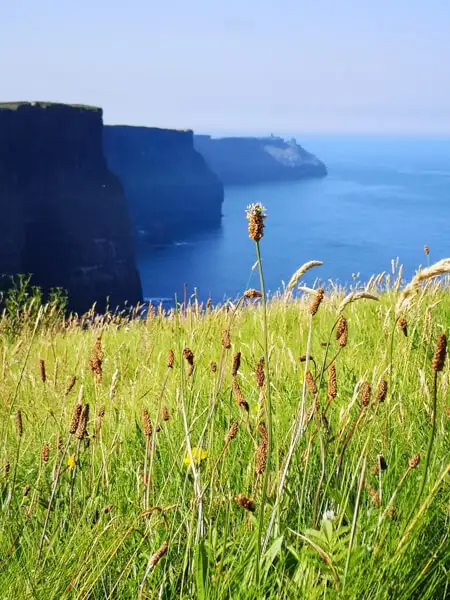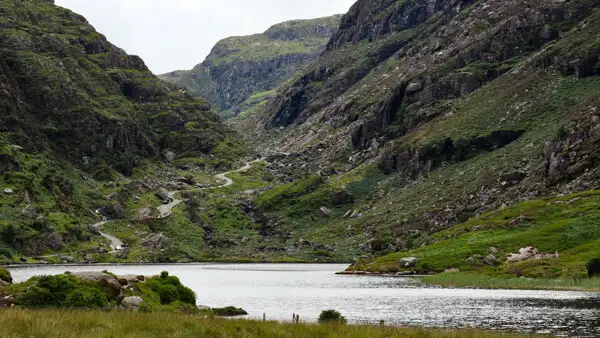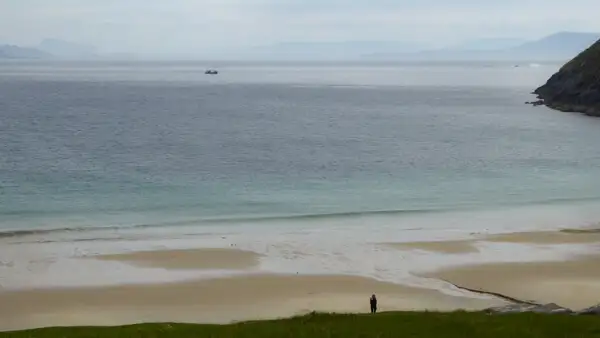Planning a trip to Ireland by bike? Great! Is your bike already prepared?
If not, and if you’re wondering what you actually need, here are some great practical tips for you:
Page Contents (click line to jump the text)

Which bike for Ireland?
Let’s just start with the bike: What is the best bike for Ireland? First of all, the one you have and feel comfortable with.
That’s it. Done.
If you are thinking about buying a bike for travelling, for Ireland, or indeed any other country, ask yourself what road conditions you can expect?
In Ireland, as in many other countries, the nice little roads are often quite bumpy. The asphalt is bumpy or torn up, rolling gravel and various kinds of dirt adorn the road and every now and then there is a piece of “dirt road” or gravel road that leads to the most beautiful beach.
By the way, we live in Ireland (second home). We have travelled the island many times and know it pretty well.
And of course we know the road conditions well…
In addition, you are not alone on your bike, all your luggage is also with you. A good solid trekking bike, or a mountain bike converted to a trekking bike, is certainly a better choice for these conditions than the road bike with the very narrow tyres – makes sense?
If you have a choice: Robust, reliable, not too narrow tyres with some tread and suspension are helpful on bad roads, like in Ireland.
The carrier system
From the roads we come to the weight distribution: All the weight on the carrier and thus on the rear wheel? Typical beginner’s mistake. Your rear wheel will suffer, so will the tyre and so will your buttocks – with every pothole. Try to distribute the weight evenly.
There are great racks that allow you to mount side panniers on the rear wheel as well as on the front wheel. Luggage on the front wheel can affect the steering a bit, but if the bags and thus the centre of gravity are next to the axle, the steering still remains quite neutral.

This brings us to the low centre of gravity: try to stow heavy luggage as low as possible, then the bike won’t tip too much.
So distribute the luggage as evenly as possible at the front and back and stow heavy objects low, then the bike rides much better.
The bag system
Yes, exactly, we also have to choose bags:
Robust, absolutely waterproof and visible! I have ridden for years with Ortlieb bags and have always been very satisfied. The bags have always been 100% waterproof, the roll closure is easily accessible, they have survived crashes without any problems and they still hold up – for many years. No, this is not sponsored advertising, I paid for them myself.
There are many other good bags out there, just make sure they are well made and waterproof. What is it about visibility? As a cyclist, you are easily overlooked by cars in low visibility conditions. Panniers in eye-catching colours and with good reflectors will make you more visible!
Why am I talking about a bag system? Think about how you want to distribute your luggage on the bike: Personally, I like side panniers on the front and rear wheel, a handlebar pannier with a map pocket and a small rear pannier on the rear rack. There are also frame bags and other bags – try them out in the shop to see what suits you best and hinders you the least when cycling.
This includes water bottles – at least one on the frame for quick access makes a lot of sense, you can also hang two on the frame, or one or two bottles on the back of the saddle – whatever you like.
Also think about where you will put valuables if you ever leave the bike for sightseeing. What valuables do you have with you? Money, ID, plane tickets, mobile phone, tablet, Gopro, medication,…? That determines how big your portable solution should be. A small backpack, or a handlebar bag with shoulder strap, or a small fanny pack (banana)? Again, there are several options – pick one that is practical for you.
Tyres, pump, puncture repair tools
I recommend high-quality, sturdy tyres, not too narrow, with some tread so that if there is a bit of dirt on the road, they won’t slip right away. There are also inserts that can protect against penetration by nails or the like, and I would also choose really high-quality inner tubes.

In Ireland, punctures caused by nails or screws in the gravel are not uncommon. Take at least one spare inner tube, as well as a repair kit and tyre levers. A spare valve is also a good idea.
You will also need a good air pump. If the hand pump is too much effort for you, there are also good compact and light foot pumps for on the road.
Other tools and parts
Expect to find everything you need in Dublin, some in Cork or Galway and pretty much nothing in the countryside!
There are of course bike shops in small towns, but far fewer than in Germany.
What does that mean? Take what you might need with you: a good bicycle tool kit with which you can carry out the typical small repairs on the road: Handlebars not straight, saddle doesn’t fit, steering head bearing comes loose, light bulb broken, luggage rack has lost a screw….etc.
Look at the vulnerable spots and take the appropriate spanners with you. Also pack a few spare screws in the typical sizes and spare bulbs if you don’t have LED lights. Add some wire, string and tape and you’re good to go.
Oh yes, a good but light bicycle lock should also be included, because you want to be able to park your bike securely.
Chain care
You will ride over sandy or muddy ground, it will rain, there is always salt spray in the air at the seaside – in short, your chain will suffer!
Give it a cleaning and lubrication every now and then and take what you need with you – it will thank you with smooth running and long durability. Never done it before? It’s not difficult – get advice at your local bike shop and watch a few YouTube videos on the subject.
Maybe you should take a closer look at your chain, sprocket and ring gear before your trip – time for a new set? Buy a good quality set!
Saddle and suspension
Many trekking bikes have one or more suspension systems. If you are riding on rough roads and paths, it is helpful if not all shocks are immediately hard on your wrists and tailbone.
If your bike doesn’t have suspension, you can buy a suspension saddle, suspension seatpost or suspension handlebar mount as accessories.
Speaking of saddles – if they’ve always bothered you, now might be the time to treat yourself to a good quality touring saddle (and a good pair of cycling shorts, as the two work together). I wouldn’t recommend leather saddles in Ireland because it can get wet there, plastic is more practical and less sensitive.

Navigation and maps
How do you find your route? You can put a map in the map compartment of your handlebar bag, put your mobile phone in the handlebar holder, or mount a GPS navigator with a holder.
If you have electronic solutions in mind, remember to have enough battery capacity, or a power bank – where will it be while you charge your phone?
I recommend carrying at least a second navigation solution in addition to the smartphone, because at some point the battery will run out…. A simple solution: You can plan your route in Google Maps and then print out the maps. If you laminate them, they will survive wet weather. Or buy a good weatherproof map and draw your route on it.
The flight or travel pack
How will your bike get to Ireland? If you’re travelling by plane, you’ll need travel packaging, which can be bought in good bike shops or online. If you are travelling by car and taking the ferry: The air is very salty and especially in the more open areas of the ferry, your vehicle can be bathed in salt water in bad weather – if you are transporting your bike on the rear rack or roof rack, you may want to wrap it in a tarp.
Finally
So, now I’ve given you a few practical tips for your holiday preparations – I wish you lots of fun with your travel preparations and then a wonderful cycling trip in Ireland!
More interesting articles for you
CLOTHING AND PERSONAL EQUIPMENT FOR CYCLING IN IRELAND
IS MY BIKE FIT FOR A TRIP TO IRELAND? PRACTICAL TIPS FOR CHECK AND CARE
BICYCLE TRAVEL ROUTES IN IRELAND AND NORTHERN IRELAND – WHERE IS THE BEST?
CAN I TAKE MY OWN BICYCLE TO IRELAND? PRACTICAL TIPS
Photo credits cover photo: Cliffs at Mizen Head, photo by Ulrich Knüppel-Gertberg (www.irland-insider.de, www.ireland-insider.com)